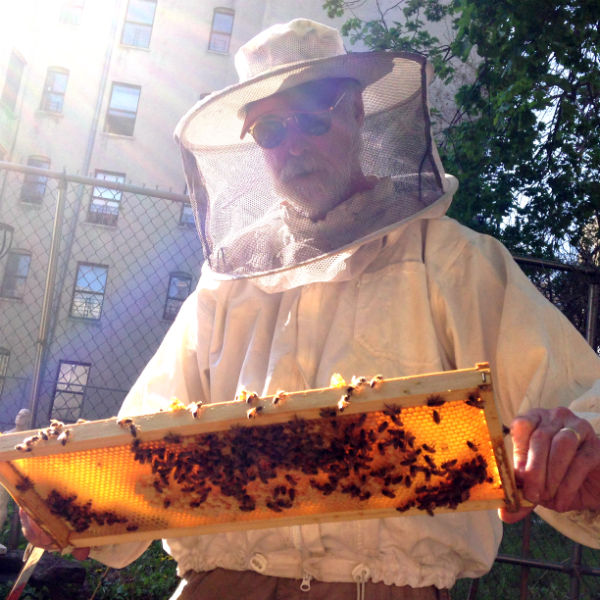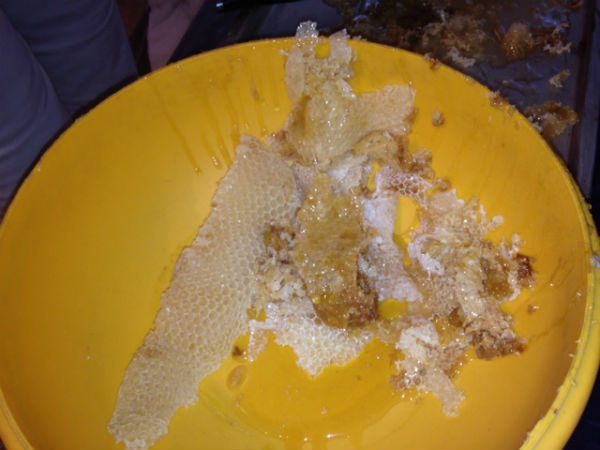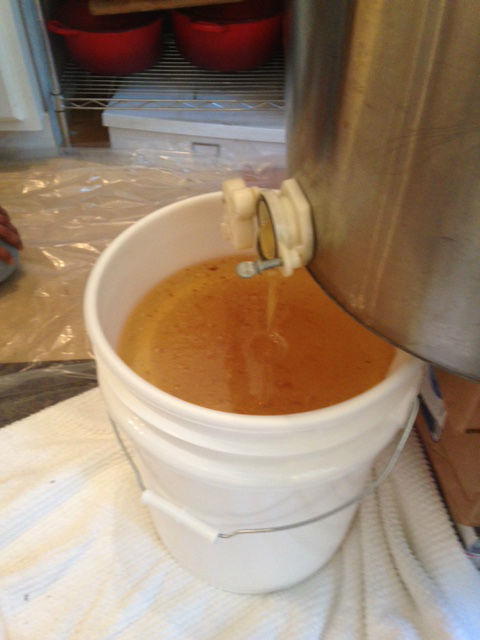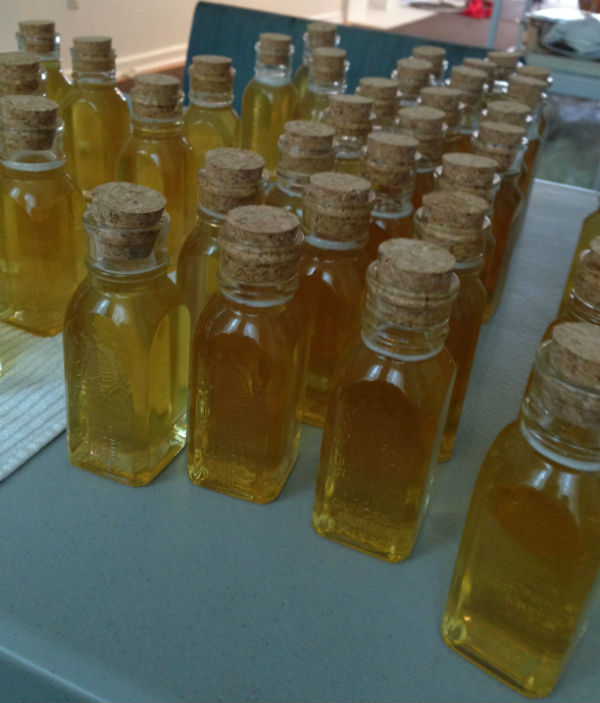 What? Harlem honey made on 119th Street, we love it! We licked our lips when we received an e-mail from the folks at Casa Frela Gallery inviting Harlem World to join their beekeepers for a first hand chance to learn about and (taste!) the Harlem honey harvest for 2015.
What? Harlem honey made on 119th Street, we love it! We licked our lips when we received an e-mail from the folks at Casa Frela Gallery inviting Harlem World to join their beekeepers for a first hand chance to learn about and (taste!) the Harlem honey harvest for 2015.
We love the idea of Harlem made honey so much, we caught up with Harlem resident and Casa Frela Gallery owner Lawrence Rodriquez (pictured with kitty) to ask him all about it:
Harlem World: Where did you get the idea for creating Harlem honey? Did you have prior experience?
Lawrence Rodriquez: As a child, I would often visit my Abuelos (Grandparents) on their farm in Texas. Unknown to me at that time I would inherit my grandparent’s appreciation and respect for planting, harvesting and beekeeping. It would be 25 years in the making that I would become an environmentalist, a steward and a beekeeper.
In 2004, I moved to the Mount Morris Historical District of Harlem in New York City. I immediately immersed myself with environmental groups that offered courses and workshops focusing on sustainably for a greener community. I started as a volunteer at first, then in 2013 I was granted a NYC Housing Preservation & Development vacant lot. Together with the help of friends, family and neighbors we built the 1st community garden on the block.
The following spring, I attended the 30th Annual GreenThumb Expo in the Bronx, and met with Gary Pelton of the New York City Beekeeping Association. I had expressed interest in beekeeping and explained that I had space in the garden to create an apiary. Within a few weeks we had two hives completely filled with 75,000 bees. After one year of maintaining the hives we have 120,000 bees are able to have two harvests in 2015. And the rest is Harlem honey history!
HW: How do you make the honey? What’s the process?
LR: Honey Bees convert nectar into honey by a process of regurgitation and evaporation. They store it as a primary food source in wax honeycombs inside the beehive. Honey gets its sweetness from the monosaccharides fructose and glucose, and has about the same relative sweetness as granulated sugar.
In July 2015 we harvested the spring honey.
Here are the steps to harvest (all done by hand):
- Opened the Hives taking out the Frames (Interior rectangle base designed to hold the honeycomb) with just honey

- Remove the Bees from the Frames by shaking the bees off.
- Remove the honey by scraping each frame.
- Uncapped the Honey, which means peeling back the wax to expose the honeycombs.

- The Honey is extracted and strained.

- Bottled the Honey.

- We invited anyone interested to come to the gallery and participate in the process. Attendees were able to taste and have the first chance to obtain the honey straight from the hives.
HW: Yum me. Is it all natural?
LR: Honey simply goes from bee to hive to bottle, Honey is nothing more than honest to goodness sweetness the way nature intended.
HW: How long have you been producing honey?
LR: Since we set up the first hives in April 2014 it took a little over a year for the first harvest of honey.
HW: Are the bees from Harlem?
LR: No, the bees are not from Harlem. The garden’s bees were ordered from Georgia. The oldest honeybee fossils have been found in Europe. But it’s thought that honey bees came from South and Southeast Asia, and the Philippines. There are seven living species of honeybees, and all but one are native to the previously mentioned areas.
HW: What is the secret sauce (the ingredients) to produce the honey? Can you make different flavors?
LR: Well yes and no. Honey from bees that feed on specific plants render honey with unique flavors. Bees forage up to a 3 mile radius. Our bees are covering Central Park, the Mount Morris Park and in the Central Harlem area. The color and flavor of honey varies from hive to hive based on the type of flower nectar collected by the bees. Most of the nectar in our hives comes from the local trees in the spring. The maple and linden trees are good sources of nectar. In the fall, the nectar sources are mainly goldenrod and Japanese knotweed. The fall honey should be a different color from the spring honey.
The bees use their long, tubelike tongues like straws (called proboscis) to suck the nectar out of the flowers and they store it in their stomachs and carry it to the beehive. While inside the bee’s stomach for about half an hour, the nectar mixes with the proteins and enzymes produced by the bees, converting the nectar into honey. The bees have to visit 1 million flowers to make a pound of honey.
HW: Wow, that’s amazing! How do you describe the Harlem honey taste?
LR: Harlem Honey from our first harvest has a pale, gold hue. It’s a thicker honey than some and has a mellow, slightly buttery aftertaste. Our honey is a miraculous product of our honeybees and it is an exceptional treat in the summer and fall when it’s been freshly harvested.
In addition to its reputation as nature’s nutritive sweetener, research also indicates that honey’s unique composition makes it useful as an antimicrobial agent and antioxidant. The fact that it’s collected from the flowers local to Harlem is especially good news for seasonal allergy suffers because pollen is collected from the plants in our neighborhood means that it will can help reduce the symptoms associated allergies. By taking in the pollen which the honey is made one’s system builds an immunity to local irritants.
HW: When do you harvest the honey?
LR: There are two harvests per year. The first harvest was in July and the second harvest will occur in September. The fall honey is a different color because of the different source of the nectar.
HW: What are the sizes and prices of the honey?
LR: We have 4 oz. is $10, 8 oz. is $20 and 16 oz. is $40.
HW: How can someone purchase the honey online or offline?
LR: Unfortunately, we sold out of honey(5 gallons) within two weeks and we were unable to offer the purchase of honey online. It can only be purchased at Casa Frela Gallery and Nilu Gift Shop on Lenox Ave.
HW: Anything you would like to add?
LR: I would like to acknowledge HPD, GreenThumb, Citizens Committee for New York City, Partnerships for Parks, Love Your Block and The Butterfly Project for their support, grants and experience.
We’ll also let you know the date of next harvest. Hopefully you and any interested readers can come take a look at the additive-free journey that honey takes from bee to bottle. And as soon as it’s bottled it’s available for purchase. As I mentioned earlier our first harvest of 5 gallons sold out in two weeks.
HW: Where’s the gallery and what’s your contact info?
LR: Our contact info is Casa Frela Gallery, 47 West 119th Street, NYC 10026 (between 5th Avenue and Malcolm X Blvd.,), www.casafrela.com, 212.722.8577.
HW: Thank you, Lawrence.
LR: Thank you.
Photo credit (l to r): Bee keeper and Lawrence Rodriquez owner of Casa Frela Gallery, New York City.
Become a Harlem Insider!
By submitting this form, you are consenting to receive marketing emails from: . You can revoke your consent to receive emails at any time by using the SafeUnsubscribe® link, found at the bottom of every email. Emails are serviced by Constant Contact









